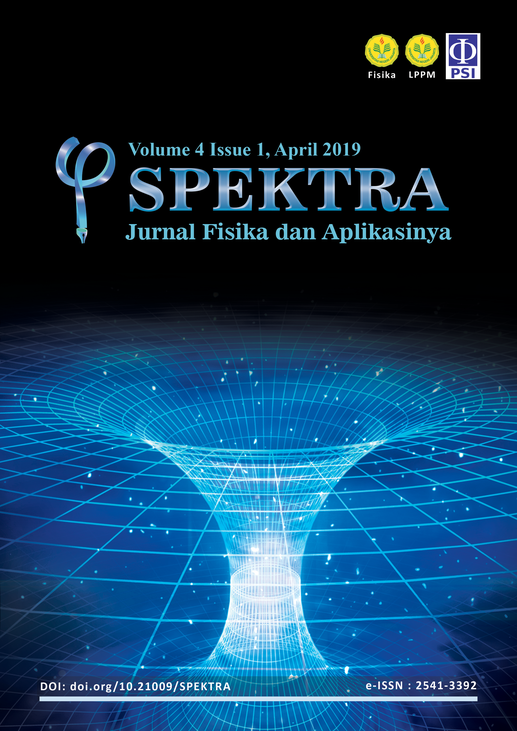ANALYSIS THE EFFECT OF PRIMARY COIL LENGTH OF TRANSFORMATOR TO THE RESULTED ELECTROMOTIF FORCE
DOI:
https://doi.org/10.21009/SPEKTRA.041.04Keywords:
Transformator, primary coil, secondary coil, kern, voltageAbstract
Transformator is an electrical device that uses a principle of solenoid wrapped in kern, and there are usually two or more coils. Each coil of the taranformator is electromagnetically connected. The transformator is made to fulfill the specific level of voltage required in the devices or systems that use alternating current electrical energy. For example, transformator tap change is design to have different number of primary turns to produce a fixed output voltage, in term there is a changing in the input voltage. This research tries to analyze the effect of the length of primary coil difference of transformator to the voltage resulted in the secondary coil. The objective of the study is producing a relationship of primary coil length variation to the resulting voltage. Variation of coil length is made from 1 cm to 15 cm with interval of 1 cm coil length. The length of the secondary coil is also varied imto 3 cm, 6 cm, and 9 cm. The test is performed by providing the same input voltage at each variation of the primary coil length and then measure the output voltage. The results show that the longer primary coil will produce the smaller output voltage in the secondary coil of tranformator. Based on the resulted graph, the relationship of the length variant of primary coil is linear to the voltage measured in the secondary coil.with determination coefficient (R2) of
0.9603, 0.9775, and 0.9822 respectively forlength of 3 cm, 6 cm, and 9 cm of the secondary coil.
References
[2] D. J. Griffiths, “Introduction to Electrodynamics,†New Jersey: Prentice-Hall, 1999.
[3] H. D. Young, R. A. Freedman, L. Ford, “University Physics with Modern Physics 12th ed.,†Addison Wesley, 2007.
[4] Hyperphysics, "Solenoid," 10 January 2017; http://hyperphysics.phy-astr.gsu.edu/hbase/magnetic/solenoid.html.
[5] B. M. E. Jati, T. K. Priyambodo, “Fisika Dasar: Listrik-Magnet-Optika-Fisika Modern,†Yogyakarta: CV. Andi Offset, 2010.
[6] W. Hayt, J Buck, “Engineering Electromagnetics, 8th ed.,†McGraw-Hill Science, 2011.
[7] U. Margono, H. Sudarmanto, “Rancang Bangun Transformator 7, 2 V/200 A sebagai Catu Daya Filamen Tabung Trioda ITK 15-2 pada Generator Cockroft Walton MBE Lateks 300keV/20mA,†Tidak Diterbitkan, Proceeding, Yogyakarta: Batan, 2012.
[8] F. Khan, S. Razzaq, “Electrodynamic energy harvester for electrical transformer’s temperature monitoring system,†Sadhana, 40(7), 2001-2019, 2015.
[9] R. Guimarães, A. C. Delaiba, J. C. Oliveira, E. Saraiva, A. P. Rosentino, “Electromechanical Forces in Transformers Caused by Inrush Currents: An Analytical, Numerical and Experimental Approach,†Journal of Control, Automation and Electrical Systems, 24(6), 2013.
[10] A. N. Novozhilov, V. N. Goryunov, T. A. Novozhilov, I. Y. Krylov, K. I. Nikitin, “Simulation of currents for relay protection of compound transformer windings from a coil short circuit,†Russian Electrical Engineering, 84(4), 2013.
[11] A. M. Sobrinho, J. R. Camacho, J. A. Malagoli, A. C. F. Mamede, “Optimization of Losses in a Three-Phase Transformer Design with Inrush Current Analysis,†Journal of Control, Automation and Electrical Systems, 29(6), 2018.
[12] F. Anggraini, A. Surtono, G. A. Pauz, “Pemanfaatan Energi Angin pada Sepeda Motor Bergerak untuk Menyalakan Lampu,†Jurnal Teori dan Aplikasi Fisika, 4(2), 2016.
[13] Mahalla, “ Pengoprasian Motor Induksi sebagai Generator untuk Pembangkitan Listrik Tenaga Mikro Hydro (PLTMH),†Jurnal Litek, 10(2), 2013.
[14] Mulyadi, “Rancang Bangun Simulator Tap Charger Transformator sebagai Pengatur Tegangan Sistem Distribusi Tenaga Listrik,†Laporan Penelitian, Bandung: Politeknik Negeri Bandung, 2012.
Downloads
Published
How to Cite
Issue
Section
License
SPEKTRA: Jurnal Fisika dan Aplikasinya allow the author(s) to hold the copyright without restrictions and allow the author(s) to retain publishing rights without restrictions. SPEKTRA: Jurnal Fisika dan Aplikasinya CC-BY or an equivalent license as the optimal license for the publication, distribution, use, and reuse of scholarly work. In developing strategy and setting priorities, SPEKTRA: Jurnal Fisika dan Aplikasinya recognize that free access is better than priced access, libre access is better than free access, and libre under CC-BY or the equivalent is better than libre under more restrictive open licenses. We should achieve what we can when we can. We should not delay achieving free in order to achieve libre, and we should not stop with free when we can achieve libre.
 SPEKTRA: Jurnal Fisika dan Aplikasinya is licensed under a Creative Commons Attribution 4.0 International License.
SPEKTRA: Jurnal Fisika dan Aplikasinya is licensed under a Creative Commons Attribution 4.0 International License.
You are free to:
Share - copy and redistribute the material in any medium or format
Adapt - remix, transform, and build upon the material for any purpose, even commercially.
The licensor cannot revoke these freedoms as long as you follow the license terms.









